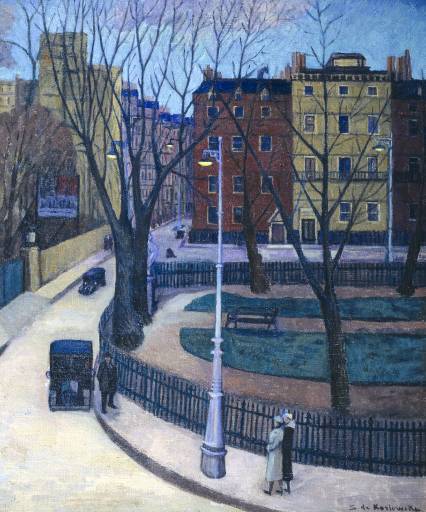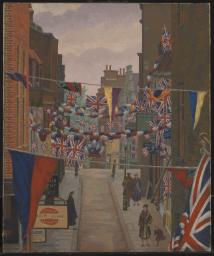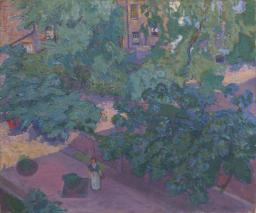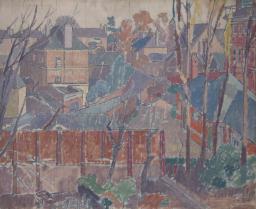Stanislawa De Karlowska Berkeley Square c.1935
Stanislawa De Karlowska,
Berkeley Square
c.1935
This view looking west down Charles Street must have been painted from an upper window in the south-east corner of Berkeley Square, London. A winter twilight scene, capturing the dim yellow of glowing street lamps, bare tree branches and subtle violet windows of the background buildings, Karlowska’s painting evokes the isolation of the modern city. Her pale streets are almost empty of people aside from two women, dwarfed by the surrounding square, walking toward a taxi in the foreground.
Stanislawa de Karlowska 1876–1952
Berkeley Square
c.1935
Oil paint on canvas
610 x 510 mm
Inscribed ‘S. de Karlowska’ bottom right
Presented by an anonymous donor 1935
N04816
c.1935
Oil paint on canvas
610 x 510 mm
Inscribed ‘S. de Karlowska’ bottom right
Presented by an anonymous donor 1935
N04816
Ownership history
Purchased for £27 6s. by a friend of the artist at the Adams Gallery, London, and presented anonymously to Tate Gallery 1935.
Exhibition history
1935
Paintings by S. de Karlowska, Adams Gallery, London, October–November 1935 (11).
1955
A Loan Exhibition of Contemporary Art, Finsbury Art Group, Finsbury Town Hall, London, May 1955 (7).
References
1935
‘Art Exhibitions: Miss S. de Karlowska’, Times, 12 October 1935, p.10.
1964
Mary Chamot, Dennis Farr and Martin Butlin, Tate Gallery Catalogues: The Modern British Paintings, Drawings and Sculpture, vol.1, London 1964, p.348.
Technique and condition
Berkeley Square is painted in artists’ oil paints on commercially prepared stretched canvas. The oval stamp of artists’ colourman and picture-frame maker Chas H. West of 117 Finchley Road, London NW3 marks the back of the canvas. The cloth has a plain, close weave and is probably composed of a mixture of linen and cotton. The canvas is attached to the stretcher with ferrous tacks in their original positions. The stretcher has four members each stamped ‘Made in England’. The cloth has been prepared with sizing and white priming. Two layers of primer have been applied, forming a coating that reduces the canvas weave texture. Both layers are composed of a mixture of materials, with titanium white in the upper layer only.1 The presence of titanium white in priming is unusual in a European painting of this date, although the date given for its use by artists is c.1920 it is rare to find it in paintings made outside of the United States before 1940.2
No initial drawing remains visible but drawn outlines, where used, occur at all levels of the painting and have been used to emphasise form and describe detail, such as the railings. The initial painting is in stiff opaque colours applied in short strokes that retain sharp textures characteristic of stiff bristle brushes and leaving many small gaps where the priming shows through. In many areas the initial paint is modified with further applications to refine detail and colour. For example, in depicting the lawns, fluid, semi-transparent greens rich in medium were laid over the touch-dry paint. This ‘glazing’ colour accumulated as small puddles in the hollows of the texture of the underlying paint but barely covers the tops of the under-painting that would not hold it. This gives parts of the surface a ‘rubbed’ appearance.
A mood of early evening is conveyed by the heightened colour values such as the glowing lamp light and contrasts between the subtle violets of the windows against the warm yellow building at the back of the square. Although some ‘local’ colours are emphasised, as in the blue of the slate roofs, in other areas such as the road and people the colour is subdued by the final local application of varnish, glazing or oiling out applied to re-saturate the surface after signing in the bottom right. This uneven layer misses some small areas in the road that appear very light, matt and cool in contrast. Its slightly opaque, warm colour markedly changes the values of the painting especially in the lower areas where it is thicker. It may be deliberately coloured or have picked up colour from the uppermost paint layers.
Roy Perry
June 2004
Notes
How to cite
Roy Perry, 'Technique and Condition', June 2004, in Robert Upstone, ‘Berkeley Square c.1935 by Stanislawa de Karlowska’, catalogue entry, May 2009, in Helena Bonett, Ysanne Holt, Jennifer Mundy (eds.), The Camden Town Group in Context, Tate Research Publication, May 2012, https://wwwEntry
During the 1930s Stanislawa de Karlowska painted a series of views of central London squares. These included Manchester Square 1930, Regent Square, Bloomsbury 1932, In Russell Square 19351 and Soho Square 1936 (private collection),2 which were all included in her retrospective exhibition at the Maltzahn Gallery in 1969. Other works include St James’s Square c.1934, The Square Gardens c.1938, The Square in Wartime 1939–40 and The Corner of the Square c.1939, listed in the memorial exhibition at the Adams Gallery in 1954, and Imperial Hotel, Russell Square (Nottingham Castle Museum) and Woburn Square (Lotherton Hall, Leeds).
The view of Berkeley Square depicted in the Tate work must have been painted from an upper window in the south-east corner, looking west down Charles Street. This high vantage point, looking down into the square is common to many of the works in Karlowska’s series, and is also similar to Spencer Gore’s high viewpoints in works such as Houghton Place 1912 (Tate N03839, fig.1). The Berkeley Square site has been redeveloped since the painting was made, but at that time the French Gallery stood on this spot.

Spencer Gore 1878–1914
Houghton Place 1912
Oil paint on canvas
support: 515 x 614 mm
Tate N03839
Presented by the Contemporary Art Society 1927
Fig.1
Spencer Gore
Houghton Place 1912
Tate N03839

Robert Bevan 1865–1925
Belsize Park 1917
Oil on canvas
750 x 903 mm
Museum of London
Photo © Museum of London
Fig.2
Robert Bevan
Belsize Park 1917
Museum of London
Photo © Museum of London
Several of Karlowska’s London square paintings, including Berkeley Square, were shown at her exhibition at the Adams Gallery in Pall Mall in 1935. These received a positive response from the critic of the Times, who observed:
In her 39 paintings ... Miss S. de Karlowska, who is the widow of Mr R.P. Bevan, excites interest and wins approval by the quiet consideration of her methods and her nice discrimination in the effects of colour. Probably her best picture is ‘St James’s Square’, in which acceptance of symmetry in the composition, with gate, statue, and tall house in a central vertical series, has produced a novel effect. ‘Berkeley Square’, apart from its gravity, pleases by the justness with which a moment of twilight has been recorded ... ‘Portman Square’, again, suggests that toned colour rather than pure colour is her natural field of enjoyment.3
Karlowska’s sequence in some ways continued her husband Robert Bevan’s practice of painting the urban environment. His pictures of Chalk Farm streets have a similar empty feel to Berkeley Square, with the expanse of the surroundings blank except for the punctuation of a small number of vehicles or figures, such as in Belsize Park 1917 (fig.2). Even allowing for the lower density of population and traffic in the 1930s in contrast to our modern experience, there is a strong sense in Karlowska’s painting of the isolation of the individual in the city, bearing similarities with the lonely London views of her contemporary, the painter Algernon Newton (1880–1968).4 Her distant female figures are dwarfed by their surroundings and the trees and buildings that rise above them. There is also a sense of passing life glimpsed from the window. The viewer, like the artist, looks down on the fleeting world of the square, as the two women walk towards a waiting taxi driver. This, in combination with the sombre lighting of the gathering dusk, evokes an elegiac atmosphere, suffused with suppressed emotion, a kind of mournful modern nocturne to the melancholy beauty of city isolation.
Robert Upstone
May 2009
Notes
Related biographies
Related essays
- Sex and the City: The Metropolitan New Woman Meaghan Clarke
Related catalogue entries
How to cite
Robert Upstone, ‘Berkeley Square c.1935 by Stanislawa de Karlowska’, catalogue entry, May 2009, in Helena Bonett, Ysanne Holt, Jennifer Mundy (eds.), The Camden Town Group in Context, Tate Research Publication, May 2012, https://www







